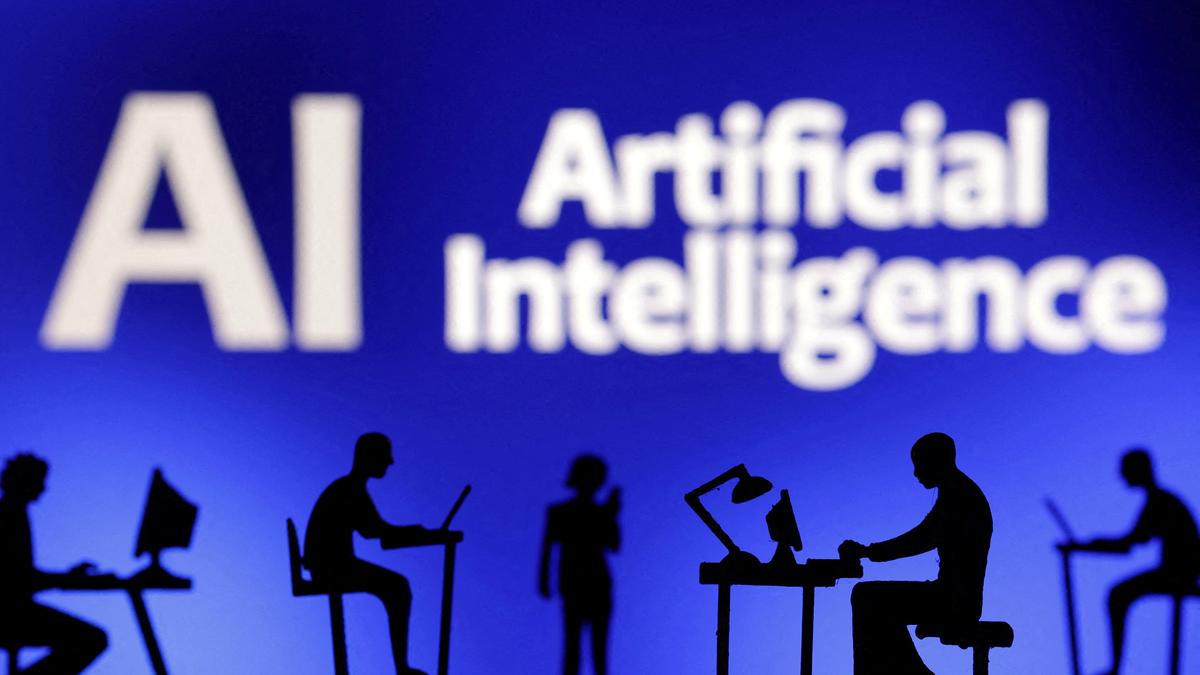Is Artificial Intelligence affecting Critical Thinking Skills?

- 13 Mar 2025
Context:
The growing integration of Artificial Intelligence (AI) in educational spaces has sparked a global debate on its impact on students' critical thinking. With AI tools like ChatGPT and Copilot becoming ubiquitous, concerns have emerged about their potential to replace the intellectual rigor traditionally expected of learners.
AI in Classrooms: An Inevitable Shift
AI is no longer a futuristic concept but an entrenched part of everyday life, including education. In India, over 61% of educators reportedly use AI tools, and globally, a majority of students now rely on generative AI for academic work. This shift raises the fundamental question: Is AI eroding students’ ability to think independently?
Experts argue that banning AI from classrooms is neither feasible nor productive. AI’s integration into platforms like Microsoft Word and Adobe Reader means its use is often passive and unavoidable. Instead, the focus should be on responsible and ethical integration aligned with course objectives.
Impact on Critical Thinking
While some educators worry that AI might lead to intellectual passivity, others assert that it depends on the pedagogy. Courses aiming to cultivate analytical thinking—like humanities—should limit AI use, whereas technical subjects such as coding might benefit from it. The evolving skillset now values the ability to validate and critique AI-generated outputs over traditional rote learning.
Yet, over-dependence is a valid concern. Students may begin accepting AI responses without questioning their validity. To address this, a shift in educational design is necessary—moving from information recall to critical engagement with AI-generated content.
AI as Infrastructure in Education
AI is increasingly being seen as critical infrastructure in academic institutions. Reports like the World Economic Forum’s Future of Jobs Report (2025) emphasize the importance of analytical thinking, adaptability, and AI-related competencies. However, there is a need for robust digital literacy training to inform users about the risks—especially data privacy and algorithmic biases.
The adoption of AI in schools and universities must be accompanied by risk audits, including assessments of embedded biases, training data integrity, and transparency in design.
Need for Regulation and Institutional Policies
India currently lacks a comprehensive regulatory framework for AI in education. In the interim, individual institutions must step in to develop internal policies guiding ethical AI use. This includes declaring course-specific AI policies and fostering dialogues among students and faculty. Global universities offer useful templates, with general guidelines complemented by course-specific rules.
Conclusion: Regulate, Don't Resist
AI’s presence in education is irreversible. Rather than resisting its use, educational institutions must adapt by promoting informed, critical engagement with AI. While AI can assist in learning, it should not substitute the cognitive processes that education aims to cultivate. The future lies in developing a balanced model, where AI complements human intelligence rather than undermining it.
Environmental Impacts of Artificial Intelligence

- 28 Feb 2025
Introduction
Artificial Intelligence (AI), encompassing technologies that simulate human thinking and decision-making, has become integral to contemporary life, influencing how we work, live, and conduct business. While AI’s foundational concepts date back to the 1950s, recent advances in computing power and data availability have fueled rapid growth. The global AI market, currently valued at $200 billion, is projected to contribute up to $15.7 trillion to the world economy by 2030. Major developments, such as the U.S.’s $500 billion Stargate Project and India's plans to build the world’s largest data centre in Jamnagar with Nvidia, highlight AI’s economic potential. However, this transformative technology also poses significant environmental challenges across its value chain.
Environmental Impact Across the AI Value Chain
The environmental footprint of AI emerges at multiple stages — from hardware production and model development to deployment and maintenance:
- Energy Consumption and Carbon Emissions:Data centres, the backbone of AI infrastructure, consume vast amounts of electricity, accounting for approximately 1% of global greenhouse gas emissions, a figure expected to double by 2026 (IEA). Advanced models like GPT-3 emit up to 552 tonnes of carbon dioxide equivalent during training, comparable to the annual emissions of dozens of cars. A single ChatGPT request consumes roughly ten times the energy of a standard Google search.
- E-Waste Generation and Resource Depletion:The rapid expansion of AI data centres exacerbates the e-waste crisis, with obsolete hardware often discarded irresponsibly. Manufacturing essential components like microchips demands rare earth minerals, mined through environmentally destructive processes.
- Water Usage:Data centres require millions of litres of water for cooling operations. Alarmingly, AI-related data centres are projected to consume six times more water than Denmark’s total usage, straining water resources, especially in regions already facing scarcity.
Global Awareness and Regulatory Efforts
Recognising the growing environmental burden, international organisations and governments have initiated efforts toward greener AI practices:
- At COP29, the International Telecommunication Union (ITU) underscored the urgent need for sustainable AI development.
- Regions like the European Union and the United States have introduced laws to mitigate AI’s environmental impact.
- However, despite over 190 countries adopting non-binding ethical AI guidelines, sustainability concerns remain largely absent from most national AI strategies.
Way Forward
To harmonise AI innovation with environmental responsibility, a multi-pronged approach is necessary:
- Clean Energy Adoption:Shifting to renewable energy sources for powering data centres and purchasing carbon credits are critical steps. Locating centres in regions rich in renewables can further lower carbon footprints.
- Efficiency in Hardware and Algorithms:Developing energy-efficient hardware and maintaining it regularly can substantially reduce emissions. Smaller, domain-specific models should be promoted to lessen computational demands.
- Optimisation of AI Systems:Studies by Google and the University of California, Berkeley, suggest that through optimised algorithms, specialised hardware, and efficient cloud data centres, the carbon footprint of large language models (LLMs) can be reduced by a factor of 100 to 1,000.
- Reusing Pre-trained Models:Businesses should prioritise fine-tuning existing models for new tasks over training fresh models from scratch, significantly saving energy.
- Measurement, Disclosure, and Accountability:Establishing global standards for tracking, measuring, and publicly disclosing the environmental impacts of AI systems is essential for fostering transparency and industry-wide accountability.
- Leveraging AI for Sustainability:AI itself can aid sustainability efforts, such as through projects like Google's DeepMind, which improves wind power forecasting, enabling better integration of renewable energy sources into national grids.
Conclusion
While AI holds immense promise for economic growth and societal advancement, it simultaneously presents critical environmental challenges. Integrating sustainability into the very design of the AI ecosystem is imperative. By embedding environmental responsibility at every stage—from model development to deployment—governments, businesses, and researchers can ensure that AI’s transformative potential is realised without compromising the planet’s future.
An AI-infused World Needs Matching Cybersecurity

- 10 May 2024
Why is it in the News?
As generative AI technology becomes more prevalent, safeguarding consumers' ability to navigate digital environments securely has become increasingly imperative.
Context:
- In recent times, the integration of generative artificial intelligence (AI) across industries has significantly transformed operational processes.
- However, this rapid advancement has also led to the emergence of new cyber threats and safety concerns.
- With incidents such as hackers exploiting generative AI for malicious purposes, including impersonating kidnappers, it is evident that a comprehensive analysis and proactive approach are required to address and mitigate the potential risks associated with this technology.
- A study by Deep Instinct revealed that 75% of professionals observed a surge in cyberattacks over the past year, with 85% attributing this escalation to generative AI.
- Among surveyed organizations, 37% identified undetectable phishing attacks as a major challenge, while 33% reported an increase in the volume of cyberattacks.
- Additionally, 39% of organizations expressed growing concerns over privacy issues stemming from the widespread use of generative AI.
Significant Impact of Generative AI & Growing Cybersecurity Challenges:
- Transformative Impact: Generative AI has revolutionized various sectors like education, banking, healthcare, and manufacturing, reshaping our approach to operations.
- However, this integration has also redefined the landscape of cyber risks and safety concerns.
- Economic Implications: The generative AI industry's projected contribution to the global GDP, estimated between $7 to $10 trillion, underscores its significant economic potential.
- Yet, the development of generative AI solutions, such as ChatGPT introduced in November 2022, has introduced a cycle of benefits and drawbacks.
- Rising Phishing and Credential Theft: An alarming surge of 1,265% in phishing incidents/emails and a 967% increase in credential phishing since late 2022 indicates a concerning trend.
- Cybercriminals exploit generative AI to craft convincing emails, messages, and websites, mimicking trusted sources to deceive unsuspecting individuals into divulging sensitive information or clicking on malicious links.
- Emergence of Novel Cyber Threats: The proliferation of generative AI has expanded the cyber threat landscape, enabling sophisticated attacks.
- Malicious actors leverage AI-powered tools to automate various stages of cyber-attacks, accelerating their pace and amplifying their impact.
- This automation poses challenges for detection and mitigation, making attacks more challenging to thwart.
- Challenges for Organizations: Organizations across sectors face escalating cyber threats, including ransomware attacks, data breaches, and supply chain compromises.
- The interconnected nature of digital ecosystems exacerbates the risk, as vulnerabilities in one system can propagate to others, leading to widespread disruption and financial losses.
- Additionally, cybercriminals' global reach and anonymity pose challenges for law enforcement and regulatory agencies.
The Bletchley Declaration: Addressing AI Challenges
- Global Significance: The Bletchley Declaration represents a pivotal global initiative aimed at tackling the ethical and security dilemmas associated with artificial intelligence, particularly generative AI.
- Named after Bletchley Park, renowned for its British code-breaking endeavours during World War II, the declaration embodies a collective resolve among world leaders to shield consumers and society from potential AI-related harms.
- Acknowledgement of AI Risks: The signing of the Bletchley Declaration at the AI Safety Summit underscores the mounting awareness among global leaders regarding AI's inherent risks, notably in the cybersecurity and privacy realms.
- By endorsing coordinated efforts, participating nations affirm their dedication to prioritizing AI safety and security on the international agenda.
- Inclusive Engagement: The Bletchley Declaration's inclusive nature is evident in the involvement of diverse stakeholders, including major world powers like China, the European Union, India, and the United States.
- By fostering collaboration among governments, international bodies, academia, and industry, the declaration facilitates cross-border and cross-sectoral knowledge exchange, essential for effectively addressing AI challenges and ensuring equitable regulatory frameworks.
- Consumer Protection Focus: At its heart, the Bletchley Declaration underscores the imperative of safeguarding consumers against AI-related risks.
- Participating countries commit to formulating policies and regulations that mitigate these risks, emphasizing transparency, accountability, and oversight in AI development and deployment.
- Additionally, mechanisms for redress in cases of harm or abuse are prioritized.
- Ethical AI Promotion: A core tenet of the Bletchley Declaration is the promotion of ethical AI practices.
- Participating nations pledge to uphold principles of fairness, accountability, and transparency in AI development and usage, striving to prevent discriminatory or harmful outcomes.
- This commitment aligns with broader endeavours to ensure responsible AI deployment for the betterment of society.
Alternative Measures for AI Risk Mitigation:
- Institutional-Level Strategies: Governments and regulatory bodies can enact robust ethical and legislative frameworks to oversee the development, deployment, and utilization of generative AI technologies.
- These frameworks should prioritize consumer safeguarding, transparency, and accountability, all while fostering innovation and economic prosperity.
- Furthermore, the integration of watermarking technology can aid in the identification of AI-generated content, empowering users to discern between authentic and manipulated information.
- This proactive approach can substantially mitigate the prevalence of misinformation and cyber threats stemming from AI-generated content.
- Continuous Innovation and Adaptation: Sustained investment in research and development is imperative to proactively address emerging cyber threats and devise innovative solutions to counter them.
- By bolstering support for cutting-edge research in AI security, cryptography, and cybersecurity, governments, academia, and industry can drive technological progress that fortifies cybersecurity resilience and mitigates the inherent risks associated with generative AI.
Conclusion
Effectively tackling the challenges presented by generative AI demands a comprehensive strategy encompassing regulatory, collaborative, and educational efforts across institutional, corporate, and grassroots domains. Through the enactment of robust regulatory frameworks, stakeholders can collaboratively mitigate the risks posed by AI-driven cyber threats, fostering a safer and more secure digital environment for all.
